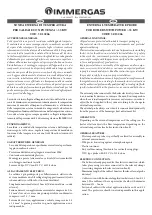
BTH Electric Boilers
USE & CARE MANUAL
(Revision August /06)
, Page
21.
Pipe sizing criteria
Proper selection of pipe size is important to
efficient system operation. A large pipe size
results in lower friction losses and may allow the
selection of smaller, more economical pump.
The increased pipe size, however, costs more
initially and must be balanced against the cost
savings realized be smaller pump. Likewise,
small pipe costs less initially but must be
balanced against the increased operating cost of
pumping water through a system with high
friction losses. An economical balance should
be reached between pump size, operating costs,
and pipe diameter.
The ASHRAE fundamentals handbook states
the general range of pipe friction loss used for
the design of hydraulic systems and upper limits
of water velocity in piping.
A variety of upper limits of water velocity and/or
pressure drop in piping and piping systems are
used. One recommendation places a velocity
limit of 4 feet per second for 2 inch and smaller
diameter pipe, and a pressure drop limit of 4 feet
of water per hundred feet for piping over 2
inches. These limitations are imposed either to
control the levels of pipe and valve noise,
erosion and water hammer pressure or for
economic reasons.
Please note that in the smaller pipe sizes, this
velocity limit permits the use of friction loss rates
higher than 4 feet per 100 feet.
Fluid velocity should be above 1-1/2 to 2 feet per
second in order to carry entrained air along to a
high point in the system where it can be purged.
It is generally accepted that if proper air control
is provided to eliminate air and turbulence in the
system, the maximum flow rate can be
established by a piping friction loss rate of 4 feet
of water per 100 feet. This allows velocities
greater than 4 feet per second in pipe sizes 2
inches and larger.
As piping ages, friction losses increase. It is
recommended that for most commercial design
purposes a safety factor of 10 to 15 % be added
to the values in the tables.
What is a “foot of water”? A column of water at
60°F, 5 feet tall, creates a constant pressure of 5
feet of water at the bottom of the column. If the
water column is 2.31 feet tall, the mass of water
creates a constant pressure (head) of one (1) psi
(pound per square inch). Pressure losses are
expressed either in “feet of water” or in psi.
Pump manufacturers usually prefer feet of water
units.
Pump or circulator selection
Performance characteristics of centrifugal
pumps are described by pump curves, which
plot flow versus head or pressure together with
other information such as efficiency and power.
Consult the manufacturer’s pump curves to
select the proper model or ask your pump dealer
or your HVAC wholesaler for a recommendation.





































